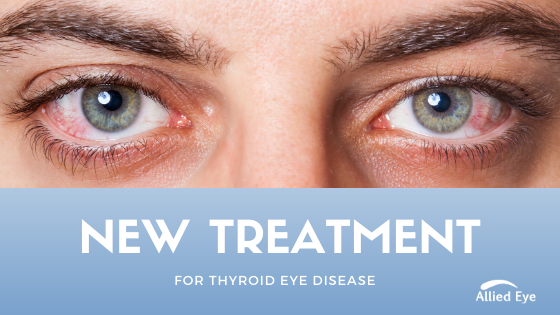
New Treatment for Thyroid Eye Disease
Thyroid eye disease is a rare autoimmune condition affecting 15,000 to 20,000 Americans annually. Usually associated with hyperthyroidism or Graves’ disease, the condition can result in vision loss. Until now, treatment for this serious disorder has been limited to steroids or surgery. However, the U.S. Food and Drug Administration (FDA) recently approved teprotumumab (Tepezza) to help adults suffering from this type of eye disease. Keep reading to learn more about thyroid eye disease and find out why ophthalmologists are excited about this new, non-surgical treatment option.
What is thyroid eye disease?
Also called Graves’ ophthalmopathy or Graves’ orbitopathy, thyroid eye disease is a complication that can develop in people with an overactive thyroid gland. The thyroid gland is located in the front of the neck and produces hormones that help the body regulate temperature and use energy. It also keeps many of the body’s systems working properly, including the heart, brain and muscles.
Graves’ disease happens when the immune system produces antibodies that cross-react with cell proteins. These antibodies, thyrotropin receptor antibodies (TRAb) or thyroid stimulating immunoglobulins (TSI) bind to thyroid cells and make them work overtime. This causes high levels of thyroid hormone to circulate in the blood stream.
When autoantibodies attach to cells behind the eyes, it activates a protein that causes the symptoms of thyroid eye disease. Up to half of the people with Graves’ develop eye problems and the condition affects women more often than men. Sometimes thyroid eye disease improves on its own, while other cases require treatment.
Symptoms of Graves’ Ophthalmopathy
If you’ve been diagnosed with Graves’ disease, be on the lookout for changes in the appearance of your eyes. You may also experience changes in your vision, although these are rare and may not occur until later, if at all. Eye changes usually begin six months before or after a diagnosis of Graves’ disease.
- Red eyes
- Inflamed eyes
- Gritty or irritated eyes
- Eyes bulging (proptosis)
- Eye misalignment (strabismus)
- Eye pain
- Light sensitivity
- Double vision (diplopia)
- Decreased eye movement
- Incomplete closure of the eyelids
- Blindness (rarely)
Many of these symptoms can be associated with other serious eye disorders. Therefore, it’s important to make sure you see your ophthalmologist as soon as possible after noticing these types of changes.
How Teprotumumab (Tepezza) Targets Thyroid Eye Disease
Teprotumumab works by blocking the insulin-like growth factor 1 receptor-mediated signaling complex on cells in the eye orbit. Simply put, the medication stops the autoimmune factors from causing inflammation in the muscles and fatty tissues behind the eye.
Teprotumumab is given through an IV—a sterile catheter inserted into a vein and secured. If approved for Tepezza therapy, expect to receive eight infusions administered once every three weeks. Most patients receive infusion therapy at a hospital or an outpatient infusion therapy center. Some medication recipients may be eligible to have infusions administered at home by a visiting nurse.
How effective is teprotumumab?
FDA approval of teprotumumab was based on impressive results from two clinical trials. Participants with moderate to severe thyroid eye disease showed significant improvement that lasted up to 72 weeks. Measurable reductions in eye bulging, eyelid swelling, double vision and orbital pain were recorded.
Additionally, quality of life scores improved after completing the recommended number of teprotumumab infusions. Participants found it easier to accomplish daily tasks that were previously difficult due to Graves’ ophthalmopathy.
If you can’t take teprotumumab, other treatment options are available for thyroid eye disease. These include steroids, eye drops and various surgical procedures. Note that radioiodine therapy should be avoided, if possible, in people with Graves’ eye disease as it can make thyroid-related eye problems worse.
References:
https://www.medscape.com/viewarticle/924051
https://www.thyroid.org/graves-eye-disease/
https://www.thyroid.org/graves-disease/
https://www.ncbi.nlm.nih.gov/pubmed/22632366
https://www.fda.gov/news-events/press-announcements/fda-approves-first-treatment-thyroid-eye-disease

